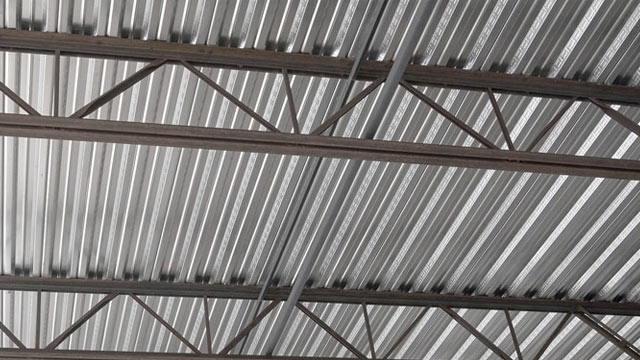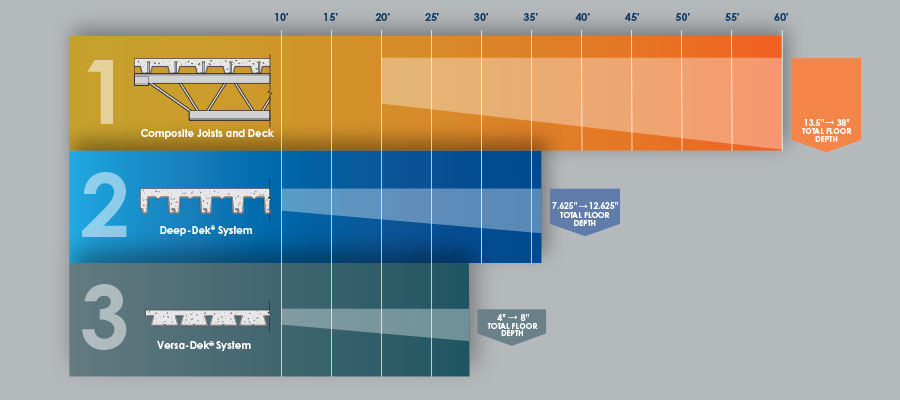
The numbers have been heading in the right direction for a long time: construction spending up, key building segments gaining market share and projections pointing up again in 2020. Building owners and project teams also like to see some numbers go down: costs, timelines and materials required, for example.
Selecting the right long-span composite system can satisfy the demands of building owners while allowing builders, suppliers, fabricators and other stakeholders to take advantage of market trends.
Long-span composite systems are engineered for the multi-story segment, whether it’s low-rise or mid-rise, multi-family or hospitality, educational or institutional, retail or manufacturing. These floor and roof systems combine the speed and versatility of steel with the performance and durability of concrete while creating wide-open spans uninterrupted by support columns. They enable cost and performance advantages. Using a long-span system is a win-win for everyone involved.

Dovetail composite deck from New Millennium Building creates narrow floors that extend unsupported up to 28 feet wall-to-wall at the Elan Heights multi-family residential facility in Houston, Texas.

At a Ferrari dealership in Michigan, a composite joist floor system supports more than 292,000 pounds of moveable live loads and spans up to 50 feet without shoring.
There are ample opportunities to reap the rewards of using a long-span composite system in multi-story construction. In the past decade, multi-family construction (apartment and condominium complexes) spending has grown roughly 18%, FMI Quarterly reported in March 2019. Spending in that segment increased 3.1% and hit a record high of $65.2 billion in December 2018 alone, according to Eye on Housing.
Several non-residential multi-story construction segments also are seeing surges in spending. Office complex spending was up $4.6 billion and manufacturing facility spending increased $3.6 billion in December 2018, Eye on Housing reported. The March issue of Architectural Products features an in-depth story about long-span composite floor systems, further indicating their rising popularity.
“Determining the appropriate long-span system for a multi-story project first requires diligent analysis and a comparison of system options,” Sean Smith, Market Development Manager at New Millennium Building Systems, writes in the August 2019 issue of Informed Infrastructure. “Whether composite joist, deep deck, or dovetail deck, the proactive engineering of that system will pay high dividends in the way of a lighter, shallower, and lower-cost building—a building that can feature gained space at the same height, efficient MEP integration, and versatile, column-free environments.”
Long-span composite systems are particularly attractive in multi-story applications because of their ability to mitigate fire and sound. These systems are fire-rated without protective coverings, and their optional acoustical treatments absorb sound energy. Each long-span system also offers overall cost and performance benefits, but they do so in different ways.

This infographic comparing spans and depths can put you on the right path.
The longest spanning system, ranging from 20 feet to 60 feet and beyond, composite joists integrate steel joists and composite deck using shear studs attached through the composite steel deck to the joist top chord. Concrete is poured on top of the decking, and the shear studs become embedded in the cured concrete, forming a unified load-bearing system that deflects as a single unit.
Composite joists serve as lighter structural elements than wide flange beams. Floor-to-floor elevations can be narrowed due to the thinner floors. Longer spans equal fewer columns and a more space-efficient design. Lighter and fewer joists mean lower costs due to the reductions in material and manufacturing, shipping and on-site staging, joist erection and joist fireproofing. The combined time saved can often lead to earlier building occupancy.
Deep-ribbed composite floor systems are most commonly used in multi-story projects requiring mid-range open spans up to 38 feet. This system will not match a composite joist system’s lengthy open spans, but it is thinner overall because it does not require additional structural depth.
Deep-ribbed composite floor systems introduce construction flexibility that cannot be replicated in standard multi-story structural systems. The deep-ribbed panels may be assembled in sections on-site, potentially saving time and money. This panelized method enables work crews to assemble floor panels on the ground before placing them on the frame using a crane.
As a base system, deep-ribbed deck has comparable acoustics to standard construction methods. When necessary deep-ribbed deck can address ambient noise. A shop-welded liner panel, called cellular or cellular acoustical, creates a flat-bottom aesthetic. The latter utilizes the entire cavity of the deep deck for an acoustical batt, enabling it to attain impressive Noise Reduction Coefficient (NRC) values. An application for this variation in deep deck is a mixed-use project that has a retail component at ground level.
Dovetail composite deck is a common choice in the multi-story residential market, especially for its ability to reduce building height. It achieves the shallowest floor depths possible while reaching spans up to 28 feet. Available in profiles as thin as 2 inches, dovetail composite is ideal for minimizing story height while maximizing ceiling height: At 28 feet, for instance, dovetail composite can be as thin as 8 inches. It is ideal for hotel and dormitories, minimizing total structure height and passing on related savings in materials, labor, weight and time. Its telltale dovetail shape also gives it an elegant, plank-like look when left exposed.
In the multi-story residential market, dovetail composite’s acoustic options are valuable. Secondary floor and ceiling acoustical treatments increase its base STC and IIC ratings.
New Millennium Building Systems offers our customers the widest range of long-span composite floor system choices for their multi-story project. Our specialists can assist you in selecting a system ideal for low-rise, mid-rise and multi-family residential construction. Contact one of our deck specialists today.
Building a better steel experience